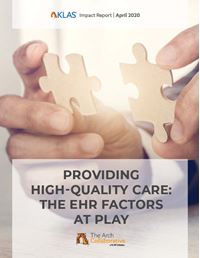Providing High-Quality Care: The EHR Factors at Play
One of the biggest promises of EHRs is that they will help healthcare providers deliver higher-quality care to their patients—the main measure of healthcare success. But do they? This report shares frontline clinicians’ feedback on how well their EHR is living up to the promise of enabling high-quality care.
Want to see full details?
Want to see full details?
Here is my information:

How Do Clinicians Successfully Leverage Their EHR for High-Quality Care?

What EHR Barriers Hinder High-Quality Care?

Dissatisfied clinicians mention many challenges that hinder their ability to deliver high-quality care. Most often, clinicians say the EHR distracts them from interacting with patients. Other EHR shortcomings include inefficiencies, unintuitive user interfaces, occasional downtime, and functionality gaps. For many, this results in a feeling that they are delivering “computer-centered care” rather than patient-centered care. They report that often they spend more time dealing with the EHR and its more frustrating aspects than they do interacting with the patient during a visit.
For some clinicians, quality care means efficiency—and many deem the EHR a roadblock in their efficiency. Charting requirements take up a lot of time and can limit how many patients that clinicians can care for in a day. Others feel that all EHRs are designed primarily for charge capture or billing—not for patient-care workflows—and therefore inherently don’t adequately support high-quality care.
Another common concern is patient safety, typically in the form of documentation errors or poor access to patient information. Clinicians sometimes feel the templated charting functionality in their EHR makes it difficult to either document sufficiently or understand others’ documentation. Others feel that poor access to essential patient information, like medical histories or orders, puts patients at risk. These types of accessibility issues usually result from lack of EHR integration or cumbersome user interfaces. Occasionally, clinicians also cite system downtime as a hindrance to patient safety.
Fortunately, KLAS has found that many of these issues can be combatted with not only strong user accountability but also organizational support. There are many organizations in the Collaborative who have helped their clinicians improve their efficiency, documentation habits, or access to patient information through training, increasing personalization use, or improving their integration. These efforts can be essential in improving providers’ care and keeping patients safe. For more details about these organizational efforts, see the Expanded Insights section.
Quantitative Data Trends Support the Voice of Clinicians
Quantitative measurements in Arch Collaborative data also back up what makes an EHR supportive (or not) of high-quality care. For example, some dissatisfied clinicians talk about alerts posing a threat to patient safety: as one said, the “high alert fatigue is frustrating and causes important messages to be overlooked.” Collaborative data backs this up—showing a strong relationship between the quality of alerts and how well the EHR enables high-quality care.

Report Non-Public HTML Body
Report Public HTML Body
This material is copyrighted. Any organization gaining unauthorized access to this report will be liable to compensate KLAS for the full retail price. Please see the KLAS DATA USE POLICY for information regarding use of this report. © 2019 KLAS Research, LLC. All Rights Reserved. NOTE: Performance scores may change significantly when including newly interviewed provider organizations, especially when added to a smaller sample size like in emerging markets with a small number of live clients. The findings presented are not meant to be conclusive data for an entire client base.



